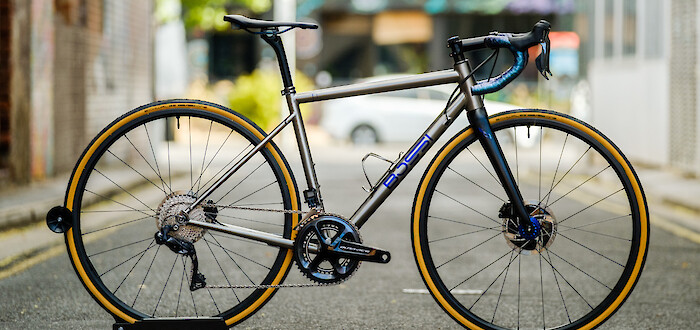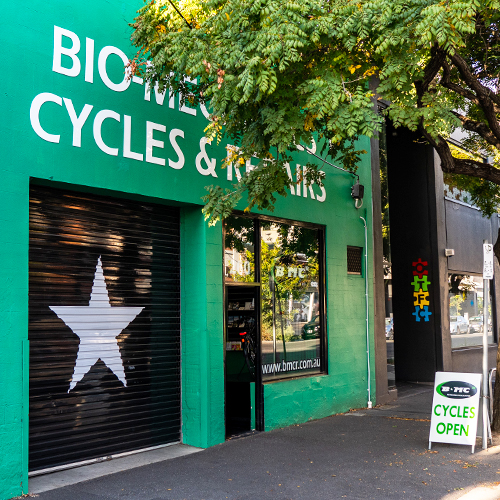Benefits of Bike Commuting


On riding to work: a caveat
Because you're reading this, there's a good chance that you already regularly ride your bike. (Hey, we know our audience.)
Perhaps you're in training for an event, or maybe you prefer to head out with your friends on the weekend on the trails or along the coast.
However, if you add riding to work into your schedule, it can have huge benefits for the rest of your cycling, as well as flow-on effects you might not expect.
If you are already a regular commuter, then this is the article you need to send to your friends, especially if they live within a handful of kilometres of their workplace.
OK! Let's get into it.
Why you should start riding to work
Sick of getting stuck in peak hour traffic? Annoyed every time you fill up your car? Tired of dealing with other people’s farts on the bus?
Good news: there’s a solution! You can ride your bike to work.
Not only will you give your cardio fitness a boost, but you'll actually be happier—and smarter—by the time you get to your desk.
If that's not enough, you’ll also save time and a whole heap of money. (Hey, you might even be able to ditch that spin class you suffer through.)
If you’ve been flirting with the idea of cycle commuting, here are seven great reasons to help you get into it.

It’s better for your brain
Want to boost your work performance? Jump on your bike.
Aerobic exercise is proven to improve your brain’s executive function – that’s the part of your brain that deals with reasoning, planning and problem-solving.
It also doesn't matter what age you are; the cognitive booster applies to young people as well as older riders.
If you're at that point where you're starting to worry about brain fade, fear not! Physical activity has been shown to slow the aging of your brain, and cycling is even being proven to be particularly good at slowing down the effect of Parkinson's. (Let this be a reminder that you're never too old to take up cycling, even if you've never worn a chamois in your life.)
Need a bit more convincing? How about sharper recall? Exercise has also been shown to help to build new brain cells which are responsible for memory. You’ll be able to remember things more quickly and easily.
Like your password after the IT department changes your logins yet again.

It’s better for your heart
Commuting by bike is the perfect way to give your cardiovascular system a boost—and you don’t need to go for hours, either. While 30 minutes a day is an ideal start, even a 3km commute is enough to give you a statistically significant increase in your physical fitness.
A 2024 Scottish study on 80,000 long-term bike commuters also found that cycling lowered their risk of an early death from any cause by 47%.
On a normal ride to work, you probably won’t be getting as breathless as you would doing interval training or climbing a 20% gradient, but this can be a good thing: medium-level intensity cardio activity still improves your heart health, and it does so without unnecesary stress on your system.
If you're training, commuting is the perfect way to add in a recovery ride. The day after a hard session, a gentle pedal to work encourages blood flow and helps with DOMS (delayed onset muscle soreness) so you can get back to smashing your PBs next time.
You can even add in some extra kms if you feel like increasing your cardio and muscular endurance. Why not take a detour on the way home and check out some back streets?

It reduces stress
Although all physical movement is beneficial, when looking directly at active transport methods, cycling consistently comes out on top — study after study have confirmed that people who ride to work are less stressed than those who don’t.
You probably know about serotonin (the happy hormone), and it's no surprise that it kicks in pretty quickly after you start riding. It also stays at an increased level during the day, so you can cope more easily with those tedious meetings.
However, did you know that physical activity is also found to activate endogenous cannabinoids, which alleviate pain, induce mild sedation and increase euphoria? These cannabinoids also have anxiolytic effects, similar to anti-anxiety medications.

These chemical reactions boost your energy levels but they also can help address mild to moderate depression—double bonus!
But that's not all.
Nearly every bike rider knows how effective it is for clearing your mind, but it's also brilliant for solving problems.
A ride—even a short one—has a way of putting things into perspective. Daunting issues somehow become less scary. Solutions often just pop out of thin air while you're riding along, even if you weren't actively thinking about them.
Get on your bike, and you’ll arrive at work ready for problem-solving. The ride home is also a great way to de-stress, rather than sitting and staring at someone else’s bumper/back of their head.
Whether it’s the brain chemicals fizzing away or just the fact that it’s fun to whiz past a bunch of people who are stuck in traffic, it’s hard to end a ride grumpier than when you started it.

It’s cheaper than driving or taking the bus
At the time of writing, unleaded petrol was costing between $1.55 and $1.96 per litre.
Let’s look at how those numbers actually stack up over a year.
In 2022, the average car owner in Adelaide paid $94 per week in petrol, which adds up to an annual cost of just under $5000.
But that’s not all drivers get the pleasure of paying for.
Factor in insurance, rego and servicing, and most motorists are outlaying almost $10,000* every single year.
And we haven’t even included the cost of parking.

OK, so cars are crazy expensive. What about catching a bus or a train instead? Both are certainly cheaper than the car; regular commuting via either mode of transport will set you back around $1400 per year, assuming you’re using a 28-day Metro pass.
However!
Consider this versus the cost of riding your bike for a year.
Looking at our own records (and we have a lot of records), the average yearly service cost for a typical commuter bike without suspension is around $600-700, including things like tyres, cables, etc. Just think of what else you can spend your leftover money on.
Even if you buy a brand new commuting bike, it's still going to be far cheaper than running your car for a year. For a mere fifth of your car's annual running costs, you can walk out of a shop with a durable, comfortable mode of transport which will last you for years.
Oh, did we mention that a new bike won't depreciate like a new car will? Cars usually lose around 15% of their value as soon as you drive one off the dealer's lot, and then lose another 15% by the end of the first year you've owned it.

As an extra bonus, commuting can also replace the ongoing cost of a gym membership.
Who needs to drive to a fitness centre and then sit on a stationary bike when you can, you know, just ride a bike in the first place?
You can get all of the same benefits, but you're also outside, getting fresh air in your lungs and Vitamin D—a hormone which your body can’t produce by itself—from the sun.
You can also hear, smell and see things that other people won’t. You're better connected to the environment around you. Who cares about the occasional spot of rain when you can watch the world unfold in real time rather than glaze over in front of a display screen or terrifyingly peppy gym instructor?
And you don’t need to deal with other people’s sweaty butts and germs, either.

It can be faster than driving or using public transport
Obviously this depends on how far you’re riding and in what conditions, but in peak hour traffic, it will be rare for a car to beat a bicycle into or out of the CBD.
We’ve tested this on several occasions where one of us has ridden to the shop where the other has driven; the bike has won every time.
You’re also not spending time waiting for trains or buses that are late or don’t show up. Nor are you having to stop every few minutes to let people on or off (unless you’re piloting the bike bus).
Riding a bike also gives you far more flexibility when it comes to your route. You don’t have to stick to the streets – you can take pathways, parkland trails, footpaths, and those nifty one-way streets that bikes have right of way on.
Say goodbye to traffic lights and say hello to being the first one to the coffee machine in the morning.

It supports cycling infrastructure
Now this one is a biggie. It's also the reason why it's so important to encourage as many people as possible to get out on their bikes (and why you should send this article to your non-commuting friends).
For those who have never ridden a bike to work, there can be the perception that it's scary or unsafe. Cycle commuting is neither of those things (unless you decide to commute down South Road/Main North Road, in which case ... errrr... thoughts and prayers).
Do you know one of the fastest ways to make it safer to ride a bike? Get more people cycling.
It may sound strange, but as the number of bike riders goes up, the chance of you getting hit by a car goes down. The term ‘there’s safety in numbers’ is literally true when it comes to cycling, and the safety aspect applies to pedestrians as well.
You'd also think that as more people cycle, the number of rider/car accidents would naturally go up, but the reverse actually happens. Research (see link above) even shows that if a community doubles the number of people cycling, the number of bike/car accidents drops by a third.

This phenomenon is prompted by the fact that, in the face of increased cycling participation, motorists actually change their behaviour to drive more safely.
Whether it's because drivers are forced to be aware of people on bikes simply because they see them more often or because maybe they know someone who rides—whatever it is, we're taking it as a win.
And, yes, we can hear the protests about rude drivers already—we've all encountered a dude in a ute who's decided that we've personally offended him by existing—, but the statistics show the actual behavioural trend.
Also, we tend to remember the one driver who yelled at us and not the 99 who went past us without incident.
Humans tend to remember the bad stuff, for reasons that haven't quite yet been explained.
But back to commuting.

The second important way to make cycling safer is to increase and improve cycling infrastructure.
It’s far easier to get support for new paths or improvements if there’s demonstratable demand for these facilities.
Let’s face it – councils are notoriously hesitant to roll out bike paths in particular because of the perceived problem of lost car parking spaces.
There's also the constant myth that taking away parking spots and/or reducing road speed will lead to a downturn in business, despite the irrefutable, ongoing, worldwide evidence that shows the opposite.
Historically, despite what they might put out in their media releases, councils are rarely focused on things which are going to give the greatest long-term benefit to their community. Council members generally want to get re-elected, so they often fold in the face of protest, even if those protesting against implementing safe cycling options are frustratingly myopic.

Consider the Sturt Street bikeway debacle.
It cost $400,000 but was so badly designed that most people hated it (including many bike riders). Adelaide City Council took this as a sign that people didn’t want bike lanes at all, and ripped it out (again, at great expense).
Every bike path since then continues to be an uphill battle, no pun intended.
So don’t give them the chance to do the old “we built a bike path once and nobody used it” tango – get out there on it, get your friends out on it, and show them that it’s needed.
And if a motorist ever argues with you about more bike lanes, just remind them: every person on a bike is one less car that they have to deal with. Just think of all the free parking spots they'll have!

By riding to work, not only are you reaping all of the benefits we've covered but you're also modelling positive behaviour for other people. The more people who ride, the more other people want to join in.
You may have felt this yourself, if you've ever passed a group ride or seen scores of people happily cruising along next to the Torrens—it's inspiring.
You on a bike could be the reason why someone who's been hesitating about riding to work actually gets out and does it.
So ride, and be that person for someone else, for your friends and family.

Who's ready to ride to work?
Bike commuting isn't just a practical way to dodge traffic and save money—it'll benefit your body and mind as well. (Hell, we haven't even touched on the fact that it's far better for the environment. We figured y'all already knew that.)
So forget sitting like a sack of flour behind a steering wheel. Get out there, enhance your cardiovascular health, boost your brainpower, alleviate stress, and contribute to safer roads for everyone.
And kiss Greenhill Road congestion goodbye forever.
Need to get your bike commute-ready? That's what we're here for.

All the research
Want to keep reading? Sure you do!
- Health benefits of pedestrian and cyclist commuting: evidence from the Scottish Longitudinal Study
- Cycling for health: improving health and mitigating the climate crisis
- Riding to work linked to better mental health
- Does cycle commuting reduce the risk of mental ill-health? An instrumental variable analysis using distance to nearest cycle path
- Aerobic Exercise Improves Cognition, Even in Young Adults
- Benefits of outdoor exercise confirmed
- A Problem Solving Approach to Movement Skill Acquisition: Implications for Special Populations
- Exercise-Mediated Neurogenesis in the Hippocampus
- A Virtuous Cycle: Safety In Numbers For Bicycle Riders
- Economic impacts on local businesses of investments in bicycle and pedestrian infrastructure: a review of the evidence
- The Complete Business Case for Converting Street Parking Into Bike Lanes


